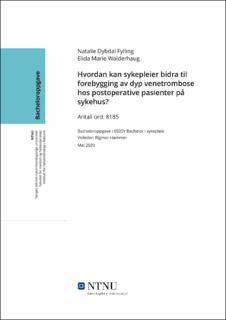| dc.contributor.advisor | Hammer, Rigmor | |
| dc.contributor.author | Fylling, Natalie Dybdal | |
| dc.contributor.author | Walderhaug, Elida Marie | |
| dc.date.accessioned | 2020-07-07T16:08:19Z | |
| dc.date.available | 2020-07-07T16:08:19Z | |
| dc.date.issued | 2020 | |
| dc.identifier.uri | https://hdl.handle.net/11250/2661242 | |
| dc.description.abstract | Hensikt: Årlig får 2 av 1000 mennesker over 50 år dyp venetrombose. Dette er en tilstand som kan medfølge sykdom og komplikasjoner som lungeemboli, og omtrent 4.500 pasienter behandles for dyp venetrombose eller lungeemboli årlig på norske sykehus. Hensikten med denne oppgaven er å sette søkelys på dyp venetrombose, og hvordan sykepleiere kan bidra til forebygging av tilstanden. Møtearenaen i dette tilfelle er sykehus. Oppgaven tar for seg kirurgiske pasienter ettersom én av tre tilfeller av dyp venetrombose skyldes nettopp kirurgi.
Metode: Dette er en systematisk litteraturstudie. Den inneholder åtte forskningsartikler, hvorav en er kvalitativ, fem er kvantitative og to er både kvalitativ og kvantitativ. Artiklene er analysert og likheter og ulikheter er presentert.
Resultat: Det største funnet, som var felles blant flere av forskningsartiklene, var mangelen på kunnskap blant sykepleiere om dyp venetrombose. Dette viste seg å føre til utelatelse av risikovurdering, profylakse, mobilisering og viktig dokumentering. Det kom også frem at retningslinjene som sykehusene har ikke alltid blir fulgt opp da de ikke er tilgjengelig nok for personalet. Forskningen viste at kursing om dyp venetrombose blant helsepersonellet førte til en signifikant økning i kunnskapsnivå.
Konklusjon: Når det kommer til dyp venetrombose er det behov for å øke kunnskapsnivået blant sykepleiere. Dersom sykepleiere har god forståelse for tilstanden og konsekvensene det kan medføre, er sannsynligheten større for at forebyggende arbeid og retningslinjer blir fulgt opp. På den måten kan sykepleiere bidra til forebygging av dyp venetrombose hos postoperative pasienter på sykehus. | |
| dc.description.abstract | Aim: Each year 2 out of a 1000 people over the age of 50 experience deep vein thrombosis. This is a medical condition in which diseases and complications often can develop such as pulmonary embolism. There are roughly 4,500 patients that get treated for deep vein thrombosis or pulmonary embolism each year in norwegian hospitals. The purpose of the thesis is to highlight the medical condition that is deep vein thrombosis, and convey how the nurses can contribute to the prevention of the said condition. The setting in which this is taking place is in the hospital. The thesis is mainly about post-operative patients as one out of three cases of deep vein thrombosis occurs due to surgery.
Methods: This is a systematic literature review. It contains eight different research articles where one is based on qualitative research, five are based on quantitative research and two are based on both qualitative and quantitiave research. The articles are analyzed; similarities and differences are presented.
Results: The biggest discovery, which was common among several of the research articles, was the lack of knowledge among the nurses on the topic of deep vein thrombosis. This was proven to lead to neglect of risk assesment, prophylaxis, mobilization and important documentation. As well negligence, there were also guidelines not followed by the nurses in the hospital due the unavailability to each of the employees. Research shows that training and courses about deep vein thrombosis among the personnel led to a significant increase in knowledge.
Conclusion: When it comes to deep vein thrombosis it is necessary to increase the knowledge in which the nurses possess. However, if the nurses have a deeper understanding of the medical condition and the consequences it may lead to the bigger the chances are of preventive work as well as having the guidelines be carried out. This way the nurses will be able to contribute to the prevention of deep vein thombosis among postoperative patients in hospitals. | |
| dc.publisher | NTNU | |
| dc.title | Hvordan kan sykepleier bidra til forebygging av dyp venetrombose hos postoperative pasienter på sykehus? | |
| dc.type | Bachelor thesis | |
